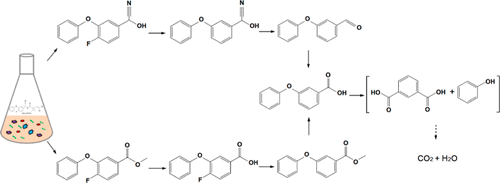当前位置:
X-MOL 学术
›
J. Agric. Food Chem.
›
论文详情
Our official English website, www.x-mol.net, welcomes your feedback! (Note: you will need to create a separate account there.)
Biodegradation Pathway and Detoxification of β-cyfluthrin by the Bacterial Consortium and Its Bacterial Community Structure
Journal of Agricultural and Food Chemistry ( IF 6.1 ) Pub Date : 2022-06-14 , DOI: 10.1021/acs.jafc.2c00574 Haiyun Li 1, 2 , Yachun Ma 1 , Tuo Yao 1 , Li Ma 3 , Jiangui Zhang 1 , Changning Li 1
Journal of Agricultural and Food Chemistry ( IF 6.1 ) Pub Date : 2022-06-14 , DOI: 10.1021/acs.jafc.2c00574 Haiyun Li 1, 2 , Yachun Ma 1 , Tuo Yao 1 , Li Ma 3 , Jiangui Zhang 1 , Changning Li 1
Affiliation

|
In the process of microbial degradation of pyrethroid pesticides, the synergistic effect of the microbial community is more conducive to the complete degradation of toxic compounds than a single strain. At present, the degradation pathway of pyrethroids in a single strain has been well revealed, but the synergistic metabolism at the community level has not been well explained. This study elucidated the bacterial community succession, metabolic pathway, and phytotoxicity assessment during β-cyfluthrin biodegradation by a novel bacterial consortium enriched from contaminated soil. The results showed that the half-life of β-cyfluthrin at different initial concentrations of 0.25, 0.5, 0.75, and 1.0 mg mL–1 were 4.16, 7.34, 12.81, and 22.73 days, respectively. Enterobacter was involved in β-cyfluthrin degradation metabolism in the initial stage, and other bacterial genera (Microbacterium, Ochrobactrum, Pseudomonas, Hyphomicrobiaceae, Achromobacter, etc.) significantly contribute to the degradation of intermediate metabolites in the later stages. Functional gene prediction and metabolite analysis showed that xenobiotic biodegradation and metabolism, especially benzoate degradation and metabolism by cytochrome P450 were the major means of β-cyfluthrin degradation. Further, two degradation pathways of β-cyfluthrin were proposed, which were mainly ester hydrolysis and oxidation to degrade β-cyfluthrin through the production of carboxylesterase and oxidoreductase. In addition, the inoculated bacterial consortium could degrade β-cyfluthrin residues in water and soil and reduce its phytotoxicity in Medicago sativa. Hence, this novel bacterial consortium has important application in the remediation environments polluted by β-cyfluthrin.
中文翻译:

细菌群落及其细菌群落结构对β-氟氯氰菊酯的生物降解途径和解毒作用
在拟除虫菊酯类农药的微生物降解过程中,微生物群落的协同作用比单一菌株更有利于有毒化合物的完全降解。目前,拟除虫菊酯在单一菌株中的降解途径已得到很好的揭示,但群落水平的协同代谢尚未得到很好的解释。本研究阐明了一种从污染土壤中富集的新型细菌聚生体在 β-氟氯氰菊酯生物降解过程中的细菌群落演替、代谢途径和植物毒性评估。结果表明,β-氟氯氰菊酯在不同初始浓度0.25、0.5、0.75和1.0 mg mL -1下的半衰期分别为4.16、7.34、12.81和22.73天。肠杆菌属早期参与 β-氟氯氰菊酯降解代谢,其他细菌属(Microbacterium , Ochrobactrum , Pseudomonas , Hyphomicrobiaceae , Achromobacter等)显着促进后期中间代谢物的降解。功能基因预测和代谢物分析表明,外源生物降解和代谢,尤其是细胞色素P450对苯甲酸盐的降解和代谢是β-氟氯氰菊酯降解的主要途径。此外,提出了 β-氟氯氰菊酯的两种降解途径,主要是酯水解和通过产生羧酸酯酶和氧化还原酶氧化降解 β-氟氯氰菊酯。此外,接种菌群能降解水和土壤中的β-氟氯氰菊酯残留,降低其对紫花苜蓿的药害。因此,这种新型细菌联合体在 β-氟氯氰菊酯污染的修复环境中具有重要应用。
更新日期:2022-06-14
中文翻译:

细菌群落及其细菌群落结构对β-氟氯氰菊酯的生物降解途径和解毒作用
在拟除虫菊酯类农药的微生物降解过程中,微生物群落的协同作用比单一菌株更有利于有毒化合物的完全降解。目前,拟除虫菊酯在单一菌株中的降解途径已得到很好的揭示,但群落水平的协同代谢尚未得到很好的解释。本研究阐明了一种从污染土壤中富集的新型细菌聚生体在 β-氟氯氰菊酯生物降解过程中的细菌群落演替、代谢途径和植物毒性评估。结果表明,β-氟氯氰菊酯在不同初始浓度0.25、0.5、0.75和1.0 mg mL -1下的半衰期分别为4.16、7.34、12.81和22.73天。肠杆菌属早期参与 β-氟氯氰菊酯降解代谢,其他细菌属(Microbacterium , Ochrobactrum , Pseudomonas , Hyphomicrobiaceae , Achromobacter等)显着促进后期中间代谢物的降解。功能基因预测和代谢物分析表明,外源生物降解和代谢,尤其是细胞色素P450对苯甲酸盐的降解和代谢是β-氟氯氰菊酯降解的主要途径。此外,提出了 β-氟氯氰菊酯的两种降解途径,主要是酯水解和通过产生羧酸酯酶和氧化还原酶氧化降解 β-氟氯氰菊酯。此外,接种菌群能降解水和土壤中的β-氟氯氰菊酯残留,降低其对紫花苜蓿的药害。因此,这种新型细菌联合体在 β-氟氯氰菊酯污染的修复环境中具有重要应用。



























 京公网安备 11010802027423号
京公网安备 11010802027423号